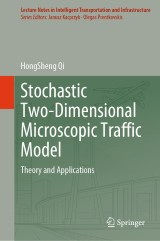Details

Stochastic Two-Dimensional Microscopic Traffic Model
Theory and ApplicationsLecture Notes in Intelligent Transportation and Infrastructure
|
181,89 € |
|
| Verlag: | Springer |
| Format: | |
| Veröffentl.: | 26.07.2024 |
| ISBN/EAN: | 9789819735976 |
| Sprache: | englisch |
| Anzahl Seiten: | 300 |
Dieses eBook enthält ein Wasserzeichen.
Beschreibungen
<p>Microscopic traffic model serves as the foundation of traffic flow theory and is the basis for applications such as traffic simulation, autonomous vehicle simulation, and digital twin technology. Conventional traffic models have primarily focused on the longitudinal dimension and have been deterministic in nature. However, vehicles' movements involve both longitudinal and lateral dimensions, and their dynamics are inherently stochastic. Therefore, a two-dimensional treatment is essential.</p><p>This book explores the theory and application of stochastic two-dimensional microscopic traffic models, including the development of theory, establishment of methods, and applications to autonomous vehicles. The book is organized into three sections: data, theory, and application. In the data section, various open-source trajectory data are analyzed and noise reduction techniques are discussed. In the theory section, various two-dimensional traffic models are developed. In the application section, the potential applications of these models are discussed, including behavioral inferences and lateral wandering. This book will be a useful reference for students, researchers and engineers in the fields of vehicle engineering and traffic technology. </p>
<p>Noise reduction filtering and behavioral estimation for human driven vehicles.- Predictability analysis of driving behavior.- Two dimensional stochastic microscopic traffic model for human driven vehicles.- Two dimensional driving behavioral model considering vehicle dynamics.- Stochastic two dimensional microscopic driving model for intelligent vehicles.- Risky driving behavior with two dimensional jerk and wandering.- Capacity adjustment factor considering lateral influence for multi lane road.- Real time estimation of driving behaviors.- Stochastic lateral wandering of progressive autonomous vehicles flow.- Test scenario generation for autonomous vehicles considering the predictability.</p>
<p>Dr. HongSheng QI received his B.E. and M.E. degrees in Traffic Engineering from Jilin University in 2006 and 2008, respectively, and his Ph.D. degree in Transportation Engineering from Jilin University in 2011. He then completed a postdoctoral research position at Zhejiang University. Since 2014, Dr. QI has been employed as Assistant Professor and, later, Associate Professor at the College of Civil Engineering and Architecture at Zhejiang University.</p>
<p>Dr. QI's research focuses on the areas of traffic flow theory, traffic control, and data-driven traffic analysis. Since 2008, he has published over 60 peer-reviewed English papers in international journals and conferences. He currently serves as Committee Member of the World Transportation Convention (WTC), editorial board member of journal of social computing, editorial board member of CAAI Artificial Intelligence Research, and as Reviewer for several international journals. In 2021 and 2022, he was awarded the Excellent Paper Award at the World Transportation Convention. Additionally, he has been granted three US patents.</p>
<p>Dr. QI's research focuses on the areas of traffic flow theory, traffic control, and data-driven traffic analysis. Since 2008, he has published over 60 peer-reviewed English papers in international journals and conferences. He currently serves as Committee Member of the World Transportation Convention (WTC), editorial board member of journal of social computing, editorial board member of CAAI Artificial Intelligence Research, and as Reviewer for several international journals. In 2021 and 2022, he was awarded the Excellent Paper Award at the World Transportation Convention. Additionally, he has been granted three US patents.</p>
<p>Microscopic traffic model serves as the foundation of traffic flow theory and is the basis for applications such as traffic simulation, autonomous vehicle simulation, and digital twin technology. Conventional traffic models have primarily focused on the longitudinal dimension and have been deterministic in nature. However, vehicles' movements involve both longitudinal and lateral dimensions, and their dynamics are inherently stochastic. Therefore, a two-dimensional treatment is essential.</p>
<p>This book explores the theory and application of stochastic two-dimensional microscopic traffic models, including the development of theory, establishment of methods, and applications to autonomous vehicles. The book is organized into three sections: data, theory, and application. In the data section, various open-source trajectory data are analyzed and noise reduction techniques are discussed. In the theory section, various two-dimensional traffic models are developed. In the application section, the potential applications of these models are discussed, including behavioral inferences and lateral wandering. This book will be a useful reference for students, researchers and engineers in the fields of vehicle engineering and traffic technology.</p>
<p>This book explores the theory and application of stochastic two-dimensional microscopic traffic models, including the development of theory, establishment of methods, and applications to autonomous vehicles. The book is organized into three sections: data, theory, and application. In the data section, various open-source trajectory data are analyzed and noise reduction techniques are discussed. In the theory section, various two-dimensional traffic models are developed. In the application section, the potential applications of these models are discussed, including behavioral inferences and lateral wandering. This book will be a useful reference for students, researchers and engineers in the fields of vehicle engineering and traffic technology.</p>
Focuses on the two-dimensional aspects of traffic model and fills the gap of current theory gaps Considers complex environments, including the road geometry, the integration of lane changing, and car following model Provides potential applications of the model, which potentially benefit the autonomous vehicles industry
Diese Produkte könnten Sie auch interessieren:

Water Quality Hazards and Dispersion of Pollutants

von: Wlodzimierz Czernuszenko, Pawel Rowinski

149,79 €















